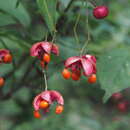Comments
provided by eFloras
This species is well known and widespread throughout E Asia. The fruit is often identified as a member of Euonymus sect. Ilicifolii because the wings are too short to observe with the naked eye; however, the other characters used to separate the sections place E. oxyphyllus in E. sect. Uniloculares.
- license
- cc-by-nc-sa-3.0
- copyright
- Missouri Botanical Garden, 4344 Shaw Boulevard, St. Louis, MO, 63110 USA
Description
provided by eFloras
Deciduous shrubs to small trees, 3-4 m tall; branches and twigs terete, sturdy, brown or dark brown when dry. Petiole less than ca. 1 cm; leaf blade thickly papery or thinly leathery, ovate-elliptic or ovate-lanceolate, 7-12 × 3.5-5 cm, base cuneate or attenuate, margin finely serrulate, apex acuminate or acute; lateral veins 5-7 pairs, netting and disappearing before reaching margin. Peduncle slender, 6-10 cm, 1-3 × dichotomously branched with several to many flowers; pedicel thin and slender, less than 10 mm. Flowers 5-merous, 6-8 mm in diam.; sepals suborbicular, short; petals white with a little purple, obovate, apex rotund or acute, base cuneate. Capsule green to brown, or yellow-brown when dry, nearly globose, ca. 1.2 cm in diam., without wings or at most slightly 5-angled. Aril bright red. Fl. Apr-Jun, fr. Aug-Nov.
- license
- cc-by-nc-sa-3.0
- copyright
- Missouri Botanical Garden, 4344 Shaw Boulevard, St. Louis, MO, 63110 USA
Distribution
provided by eFloras
Anhui, Fujian, Henan, Hubei, Hunan, Jiangxi, Liaoning, Shandong, Taiwan, Zhejiang [Japan, Korea].
- license
- cc-by-nc-sa-3.0
- copyright
- Missouri Botanical Garden, 4344 Shaw Boulevard, St. Louis, MO, 63110 USA
Habitat
provided by eFloras
Forests, woodlands; near sea level to 2300 m.
- license
- cc-by-nc-sa-3.0
- copyright
- Missouri Botanical Garden, 4344 Shaw Boulevard, St. Louis, MO, 63110 USA
Euonymus oxyphyllus: Brief Summary
provided by wikipedia EN
Euonymus oxyphyllus, the Korean spindle tree, is a species of flowering plant in the family Celastraceae, native to central and eastern China (including Taiwan), Manchuria, Korea, Japan and the Kurils. It is a shrub or small tree typically reaching 2.5 m (8 ft). The Royal Horticultural Society considers it to be a good tree for smaller gardens, especially for its colorful Autumn foliage and fruits.

Flowers are inconspicuous

Close up of flower

Ripening fruit hanging below leaves

Branch showing fruit remaining after leaf fall
- license
- cc-by-sa-3.0
- copyright
- Wikipedia authors and editors





